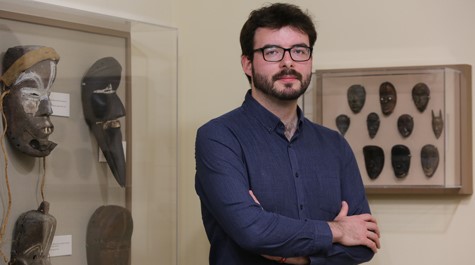Graduate research: Archaeology goes high-tech with LiDAR
Technological advances are allowing archaeologists to take a wider, yet closer, look at ancient sites, opening up long-hidden evidence about the societies of the people who lived there.
Tomos Evans is among the 21st century archaeologists using data derived from LiDAR — a method that uses pulsed-laser scans of the earth’s topography to create three-dimensional images of the landscape.
Evans, a third-year Ph.D. student in William & Mary’s Department of Anthropology, is part of an initiative to use LiDAR to preserve and study an enormous 100 mile-long African system of earthworks known as Sungbo’s Eredo, located in the southwest of Nigeria. His advisor is Neil Norman, assistant professor of anthropology.
Evans was awarded the university’s Graduate Studies Advisory Board Award for Excellence in Scholarship in the Humanities and Social Sciences. It is one of three honors bestowed in conjunction with the annual Graduate Research Symposium. This year, the symposium content is being presented in an online format in accord with the university’s social-distancing policies during the COVID-19 pandemic.
He explained LiDAR is most often deployed from aircraft, although drones have been used. LiDAR has a number of advantages over conventional aerial photography and satellite imagery, notably it can penetrate the dense vegetation that has heretofore hidden much of the detail of tropical sites such as Angkor Wat in Cambodia and the Mayan ruins of the Yucatan.
“The kinds of details we’re interested in are those deriving from the landscape modifications of past human populations,” Evans said. “These modifications vary in nature depending on the historical and cultural context of the region being surveyed.”
Sungbo’s Eredo is an excellent candidate site for LiDAR work. Thought to have been constructed around 700 years ago, it’s a complex of earthworks that appears to be more than 100 miles in circumference, overgrown by the rain forest of southwest Nigeria.
“These earthworks consist of a ‘bank-and-ditch,’” Evans explained. “Earth is removed to form a deep trench and then piled up into a bank structure, creating a deep earthen wall that is otherwise largely hidden from aerial and satellite imagery by the forest canopy. We’re also interested in associated archaeological features such as earthen mounds used for settlements and agriculture that will also be detected using this method.”
Evans is working as a member of a William & Mary team that includes the U.S. embassy in Abuja, Nigeria’s National Commission for Museums and Monuments and Augustine University, whose campus includes a portion of the Sungbo’s Eredo wall. He said one goal of the consortium is to preserve the remaining portions of the monument, portions of which have already been lost to development. LiDAR will allow researchers to construct a 3D version of the earthwork, he added.
The digital rendering of the wall also will forward the consortium’s second aim of studying Sungbo’s Eredo. Evans said he expects the LiDAR scans will reveal insights about the how the societies that built it were organized. He explained that he wants to look at the people of Sungbo’s Eredo from an “emic” as well as an “etic” perspective.
A Western anthropologist investigating an unfamiliar culture traditionally brings an “etic” perspective, typically a point of view based on Eurocentric social-sciences concepts of what makes a society and how it operates, Evans said. In contrast, an “emic” perspective attempts to understand what makes a society tick by approaching it from the viewpoint of the group being studied.
“I am interested in finding ways of weaving together the etic and the emic,” he said, incorporating emic beliefs, such as deities, deceased ancestors and other unseen spiritual entities, into the etic structures used by the traditional Western social scientist.
“These emic aspects are vitally important when trying to understand why an earthwork may have been constructed and maintained in a given cultural context,” he said. “As such, we need to think carefully about African philosophies and ways of perceiving and understanding the world that influenced the ways in which people modified their landscapes in this region.”
















